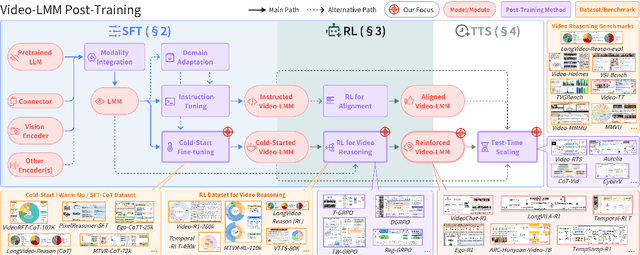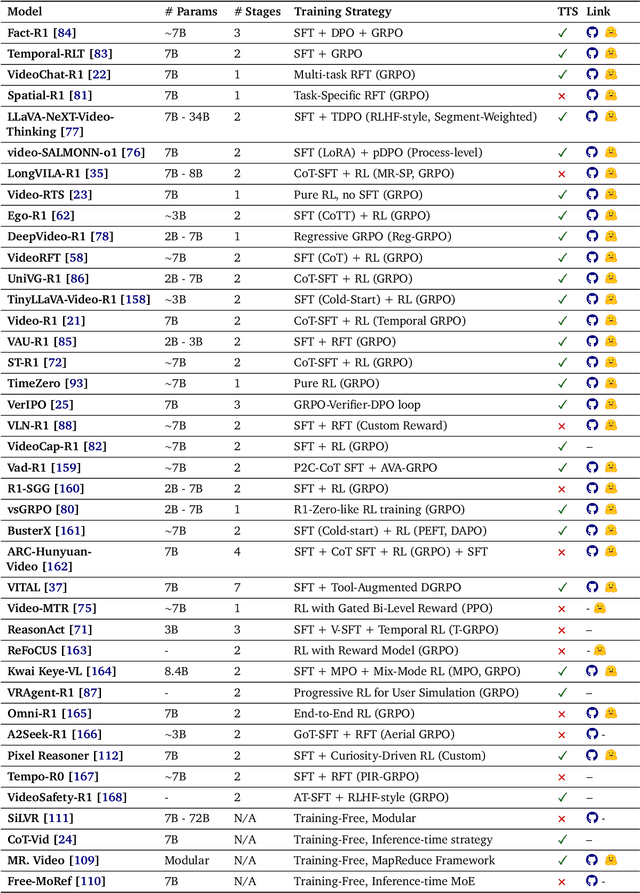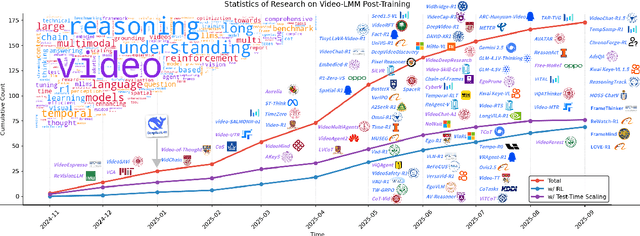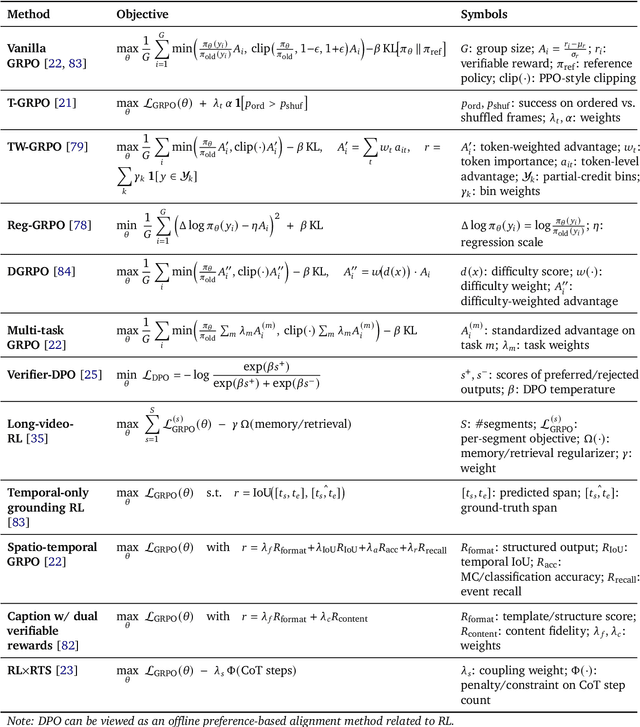Zeliang Zhang
Video-LMM Post-Training: A Deep Dive into Video Reasoning with Large Multimodal Models
Oct 06, 2025



Abstract:Video understanding represents the most challenging frontier in computer vision, requiring models to reason about complex spatiotemporal relationships, long-term dependencies, and multimodal evidence. The recent emergence of Video-Large Multimodal Models (Video-LMMs), which integrate visual encoders with powerful decoder-based language models, has demonstrated remarkable capabilities in video understanding tasks. However, the critical phase that transforms these models from basic perception systems into sophisticated reasoning engines, post-training, remains fragmented across the literature. This survey provides the first comprehensive examination of post-training methodologies for Video-LMMs, encompassing three fundamental pillars: supervised fine-tuning (SFT) with chain-of-thought, reinforcement learning (RL) from verifiable objectives, and test-time scaling (TTS) through enhanced inference computation. We present a structured taxonomy that clarifies the roles, interconnections, and video-specific adaptations of these techniques, addressing unique challenges such as temporal localization, spatiotemporal grounding, long video efficiency, and multimodal evidence integration. Through systematic analysis of representative methods, we synthesize key design principles, insights, and evaluation protocols while identifying critical open challenges in reward design, scalability, and cost-performance optimization. We further curate essential benchmarks, datasets, and metrics to facilitate rigorous assessment of post-training effectiveness. This survey aims to provide researchers and practitioners with a unified framework for advancing Video-LMM capabilities. Additional resources and updates are maintained at: https://github.com/yunlong10/Awesome-Video-LMM-Post-Training
AdvEvo-MARL: Shaping Internalized Safety through Adversarial Co-Evolution in Multi-Agent Reinforcement Learning
Oct 02, 2025Abstract:LLM-based multi-agent systems excel at planning, tool use, and role coordination, but their openness and interaction complexity also expose them to jailbreak, prompt-injection, and adversarial collaboration. Existing defenses fall into two lines: (i) self-verification that asks each agent to pre-filter unsafe instructions before execution, and (ii) external guard modules that police behaviors. The former often underperforms because a standalone agent lacks sufficient capacity to detect cross-agent unsafe chains and delegation-induced risks; the latter increases system overhead and creates a single-point-of-failure-once compromised, system-wide safety collapses, and adding more guards worsens cost and complexity. To solve these challenges, we propose AdvEvo-MARL, a co-evolutionary multi-agent reinforcement learning framework that internalizes safety into task agents. Rather than relying on external guards, AdvEvo-MARL jointly optimizes attackers (which synthesize evolving jailbreak prompts) and defenders (task agents trained to both accomplish their duties and resist attacks) in adversarial learning environments. To stabilize learning and foster cooperation, we introduce a public baseline for advantage estimation: agents within the same functional group share a group-level mean-return baseline, enabling lower-variance updates and stronger intra-group coordination. Across representative attack scenarios, AdvEvo-MARL consistently keeps attack-success rate (ASR) below 20%, whereas baselines reach up to 38.33%, while preserving-and sometimes improving-task accuracy (up to +3.67% on reasoning tasks). These results show that safety and utility can be jointly improved without relying on extra guard agents or added system overhead.
MMPerspective: Do MLLMs Understand Perspective? A Comprehensive Benchmark for Perspective Perception, Reasoning, and Robustness
May 26, 2025Abstract:Understanding perspective is fundamental to human visual perception, yet the extent to which multimodal large language models (MLLMs) internalize perspective geometry remains unclear. We introduce MMPerspective, the first benchmark specifically designed to systematically evaluate MLLMs' understanding of perspective through 10 carefully crafted tasks across three complementary dimensions: Perspective Perception, Reasoning, and Robustness. Our benchmark comprises 2,711 real-world and synthetic image instances with 5,083 question-answer pairs that probe key capabilities, such as vanishing point perception and counting, perspective type reasoning, line relationship understanding in 3D space, invariance to perspective-preserving transformations, etc. Through a comprehensive evaluation of 43 state-of-the-art MLLMs, we uncover significant limitations: while models demonstrate competence on surface-level perceptual tasks, they struggle with compositional reasoning and maintaining spatial consistency under perturbations. Our analysis further reveals intriguing patterns between model architecture, scale, and perspective capabilities, highlighting both robustness bottlenecks and the benefits of chain-of-thought prompting. MMPerspective establishes a valuable testbed for diagnosing and advancing spatial understanding in vision-language systems. Resources available at: https://yunlong10.github.io/MMPerspective/
The Sword of Damocles in ViTs: Computational Redundancy Amplifies Adversarial Transferability
Apr 15, 2025Abstract:Vision Transformers (ViTs) have demonstrated impressive performance across a range of applications, including many safety-critical tasks. However, their unique architectural properties raise new challenges and opportunities in adversarial robustness. In particular, we observe that adversarial examples crafted on ViTs exhibit higher transferability compared to those crafted on CNNs, suggesting that ViTs contain structural characteristics favorable for transferable attacks. In this work, we investigate the role of computational redundancy in ViTs and its impact on adversarial transferability. Unlike prior studies that aim to reduce computation for efficiency, we propose to exploit this redundancy to improve the quality and transferability of adversarial examples. Through a detailed analysis, we identify two forms of redundancy, including the data-level and model-level, that can be harnessed to amplify attack effectiveness. Building on this insight, we design a suite of techniques, including attention sparsity manipulation, attention head permutation, clean token regularization, ghost MoE diversification, and test-time adversarial training. Extensive experiments on the ImageNet-1k dataset validate the effectiveness of our approach, showing that our methods significantly outperform existing baselines in both transferability and generality across diverse model architectures.
Caption Anything in Video: Fine-grained Object-centric Captioning via Spatiotemporal Multimodal Prompting
Apr 09, 2025Abstract:We present CAT-V (Caption AnyThing in Video), a training-free framework for fine-grained object-centric video captioning that enables detailed descriptions of user-selected objects through time. CAT-V integrates three key components: a Segmenter based on SAMURAI for precise object segmentation across frames, a Temporal Analyzer powered by TRACE-Uni for accurate event boundary detection and temporal analysis, and a Captioner using InternVL-2.5 for generating detailed object-centric descriptions. Through spatiotemporal visual prompts and chain-of-thought reasoning, our framework generates detailed, temporally-aware descriptions of objects' attributes, actions, statuses, interactions, and environmental contexts without requiring additional training data. CAT-V supports flexible user interactions through various visual prompts (points, bounding boxes, and irregular regions) and maintains temporal sensitivity by tracking object states and interactions across different time segments. Our approach addresses limitations of existing video captioning methods, which either produce overly abstract descriptions or lack object-level precision, enabling fine-grained, object-specific descriptions while maintaining temporal coherence and spatial accuracy. The GitHub repository for this project is available at https://github.com/yunlong10/CAT-V
Forward Learning with Differential Privacy
Apr 01, 2025



Abstract:Differential privacy (DP) in deep learning is a critical concern as it ensures the confidentiality of training data while maintaining model utility. Existing DP training algorithms provide privacy guarantees by clipping and then injecting external noise into sample gradients computed by the backpropagation algorithm. Different from backpropagation, forward-learning algorithms based on perturbation inherently add noise during the forward pass and utilize randomness to estimate the gradients. Although these algorithms are non-privatized, the introduction of noise during the forward pass indirectly provides internal randomness protection to the model parameters and their gradients, suggesting the potential for naturally providing differential privacy. In this paper, we propose a \blue{privatized} forward-learning algorithm, Differential Private Unified Likelihood Ratio (DP-ULR), and demonstrate its differential privacy guarantees. DP-ULR features a novel batch sampling operation with rejection, of which we provide theoretical analysis in conjunction with classic differential privacy mechanisms. DP-ULR is also underpinned by a theoretically guided privacy controller that dynamically adjusts noise levels to manage privacy costs in each training step. Our experiments indicate that DP-ULR achieves competitive performance compared to traditional differential privacy training algorithms based on backpropagation, maintaining nearly the same privacy loss limits.
Rethinking Audio-Visual Adversarial Vulnerability from Temporal and Modality Perspectives
Feb 19, 2025



Abstract:While audio-visual learning equips models with a richer understanding of the real world by leveraging multiple sensory modalities, this integration also introduces new vulnerabilities to adversarial attacks. In this paper, we present a comprehensive study of the adversarial robustness of audio-visual models, considering both temporal and modality-specific vulnerabilities. We propose two powerful adversarial attacks: 1) a temporal invariance attack that exploits the inherent temporal redundancy across consecutive time segments and 2) a modality misalignment attack that introduces incongruence between the audio and visual modalities. These attacks are designed to thoroughly assess the robustness of audio-visual models against diverse threats. Furthermore, to defend against such attacks, we introduce a novel audio-visual adversarial training framework. This framework addresses key challenges in vanilla adversarial training by incorporating efficient adversarial perturbation crafting tailored to multi-modal data and an adversarial curriculum strategy. Extensive experiments in the Kinetics-Sounds dataset demonstrate that our proposed temporal and modality-based attacks in degrading model performance can achieve state-of-the-art performance, while our adversarial training defense largely improves the adversarial robustness as well as the adversarial training efficiency.
Generative AI for Cel-Animation: A Survey
Jan 08, 2025Abstract:Traditional Celluloid (Cel) Animation production pipeline encompasses multiple essential steps, including storyboarding, layout design, keyframe animation, inbetweening, and colorization, which demand substantial manual effort, technical expertise, and significant time investment. These challenges have historically impeded the efficiency and scalability of Cel-Animation production. The rise of generative artificial intelligence (GenAI), encompassing large language models, multimodal models, and diffusion models, offers innovative solutions by automating tasks such as inbetween frame generation, colorization, and storyboard creation. This survey explores how GenAI integration is revolutionizing traditional animation workflows by lowering technical barriers, broadening accessibility for a wider range of creators through tools like AniDoc, ToonCrafter, and AniSora, and enabling artists to focus more on creative expression and artistic innovation. Despite its potential, issues such as maintaining visual consistency, ensuring stylistic coherence, and addressing ethical considerations continue to pose challenges. Furthermore, this paper discusses future directions and explores potential advancements in AI-assisted animation. For further exploration and resources, please visit our GitHub repository: https://github.com/yunlong10/Awesome-AI4Animation
VidComposition: Can MLLMs Analyze Compositions in Compiled Videos?
Nov 19, 2024



Abstract:The advancement of Multimodal Large Language Models (MLLMs) has enabled significant progress in multimodal understanding, expanding their capacity to analyze video content. However, existing evaluation benchmarks for MLLMs primarily focus on abstract video comprehension, lacking a detailed assessment of their ability to understand video compositions, the nuanced interpretation of how visual elements combine and interact within highly compiled video contexts. We introduce VidComposition, a new benchmark specifically designed to evaluate the video composition understanding capabilities of MLLMs using carefully curated compiled videos and cinematic-level annotations. VidComposition includes 982 videos with 1706 multiple-choice questions, covering various compositional aspects such as camera movement, angle, shot size, narrative structure, character actions and emotions, etc. Our comprehensive evaluation of 33 open-source and proprietary MLLMs reveals a significant performance gap between human and model capabilities. This highlights the limitations of current MLLMs in understanding complex, compiled video compositions and offers insights into areas for further improvement. The leaderboard and evaluation code are available at https://yunlong10.github.io/VidComposition/.
Will the Inclusion of Generated Data Amplify Bias Across Generations in Future Image Classification Models?
Oct 14, 2024Abstract:As the demand for high-quality training data escalates, researchers have increasingly turned to generative models to create synthetic data, addressing data scarcity and enabling continuous model improvement. However, reliance on self-generated data introduces a critical question: Will this practice amplify bias in future models? While most research has focused on overall performance, the impact on model bias, particularly subgroup bias, remains underexplored. In this work, we investigate the effects of the generated data on image classification tasks, with a specific focus on bias. We develop a practical simulation environment that integrates a self-consuming loop, where the generative model and classification model are trained synergistically. Hundreds of experiments are conducted on Colorized MNIST, CIFAR-20/100, and Hard ImageNet datasets to reveal changes in fairness metrics across generations. In addition, we provide a conjecture to explain the bias dynamics when training models on continuously augmented datasets across generations. Our findings contribute to the ongoing debate on the implications of synthetic data for fairness in real-world applications.
 Add to Chrome
Add to Chrome Add to Firefox
Add to Firefox Add to Edge
Add to Edge